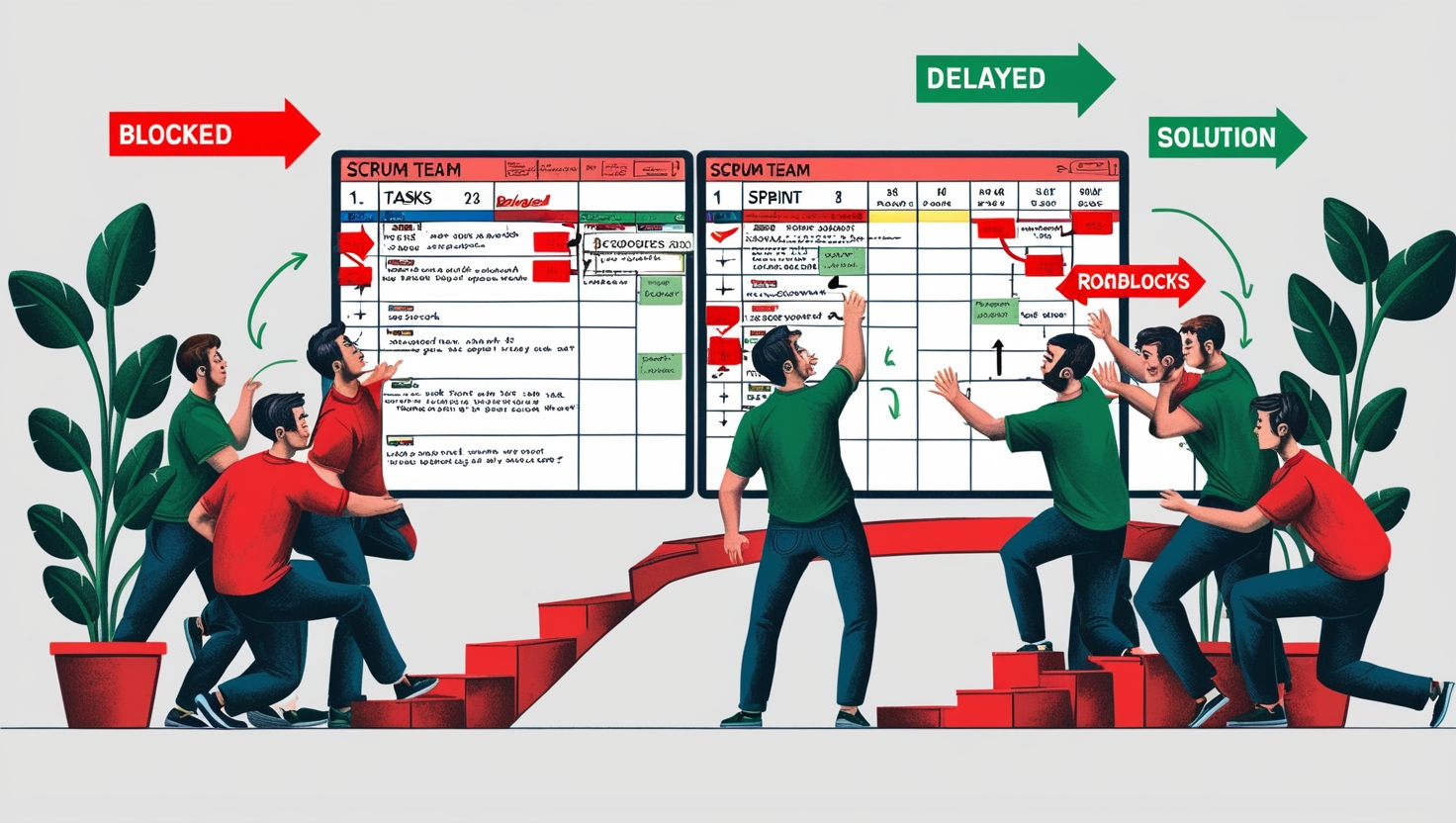Scrum roadblock
In the world of Agile project management, Scrum has long been hailed as the golden standard for delivering high-quality products efficiently. However, what if I told you that Scrum itself could be a roadblock to true Agile transformation? This surprising perspective has been gaining traction among Agile practitioners, challenging our conventional wisdom about this popular framework.
As a seasoned Agile consultant, I’ve witnessed firsthand how Scrum, when rigidly applied, can sometimes hinder rather than help teams in their Agile journey. This phenomenon, which we’ll call the “scrum roadblock,” is a critical issue that deserves our attention.
The Scrum Paradox: When the Solution Becomes the Problem
Scrum, with its well-defined roles, events, and artifacts, provides a clear structure for teams to follow. However, this very structure can sometimes become a cage, limiting the flexibility and adaptability that are core to the Agile philosophy.
In my experience working with various organizations, I’ve observed that teams often become so focused on “doing Scrum right” that they lose sight of the broader Agile principles. They religiously follow Scrum practices without truly embracing the Agile mindset, resulting in what I call “cargo cult Agile.”
Common Scrum Roadblocks and Their Impact
1. Rigid Adherence to Scrum Practices
One of the most significant roadblocks I’ve encountered is the strict adherence to Scrum practices without considering the unique needs of the team or project. This can lead to:
- Reduced flexibility in responding to changes
- Decreased team morale due to enforced practices that may not fit their workflow
- Missed opportunities for innovation outside the Scrum framework
2. Overemphasis on Scrum Artifacts
Another common roadblock is the excessive focus on Scrum artifacts like burndown charts and sprint backlogs. While these tools are valuable, I’ve seen teams spend more time maintaining them than actually delivering value to customers.
3. Scrum as a Goal Rather Than a Means
Perhaps the most insidious roadblock is when organizations view Scrum adoption as the end goal rather than a means to achieve agility. This mindset can lead to:
- Superficial changes without real cultural transformation
- Resistance to exploring other Agile methodologies that might be more suitable
- A false sense of “being Agile” while still operating in a traditional mindset
Overcoming Scrum Roadblocks: A Path to True Agility
Having identified these roadblocks, let’s explore some strategies to overcome them and unlock the full potential of Agile transformation.
1. Embrace Agile Principles, Not Just Practices
To overcome the rigid adherence to Scrum, we need to shift our focus from practices to principles. In my consulting work, I encourage teams to:
- Understand the “why” behind each Scrum practice
- Adapt practices to fit their unique context while staying true to Agile principles
- Regularly reflect on and improve their processes, even if it means deviating from standard Scrum
2. Focus on Outcomes, Not Outputs
To address the overemphasis on Scrum artifacts, I advise teams to:
- Prioritize delivering value to customers over maintaining perfect Scrum artifacts
- Use Scrum tools and artifacts as means to an end, not ends in themselves
- Regularly evaluate the usefulness of each artifact and be willing to modify or discard them if they’re not adding value
3. Cultivate an Agile Mindset
To move beyond viewing Scrum as the goal, organizations need to cultivate a true Agile mindset. This involves:
- Encouraging continuous learning and experimentation
- Being open to other Agile methodologies and hybrid approaches
- Focusing on cultural transformation rather than just process changes
Real-World Success Stories
I’ve seen remarkable transformations when organizations overcome these Scrum roadblocks. For instance, a software development company I worked with was struggling with rigid Scrum implementations across all their teams. By embracing a more flexible approach and focusing on Agile principles, they saw a 30% increase in productivity and a significant improvement in employee satisfaction.
Another client, a large financial institution, was able to accelerate their product delivery by 40% after we helped them shift their focus from Scrum compliance to customer value delivery. They achieved this by empowering teams to adapt Scrum practices and explore other Agile methodologies that better suited their specific needs.
The Road Ahead: Continuous Improvement
As we navigate the complex landscape of Agile transformation, it’s crucial to remember that Scrum is a tool, not a destination. The key to success lies in continuous improvement and adaptation.
One effective approach I’ve implemented with several clients is the use of a “Scrum Roadblock board”. This visual tool helps teams identify and address obstacles in their Scrum implementation, fostering a culture of continuous improvement.
Moreover, I encourage organizations to invest in ongoing education and coaching. By helping teams understand the broader Agile landscape and equipping them with the skills to identify and overcome roadblocks, we can create truly adaptive and high-performing organizations.
In conclusion, while Scrum remains a powerful framework for Agile project management, we must be vigilant against letting it become a roadblock to true Agile transformation. By embracing flexibility, focusing on principles over practices, and cultivating an Agile mindset, we can unlock the full potential of our teams and organizations.
Remember, the goal isn’t to do Scrum perfectly; it’s to deliver value efficiently and effectively. Let’s use Scrum as a stepping stone to agility, not a stumbling block. The journey to true Agile transformation is ongoing, and by addressing these Scrum roadblocks, we pave the way for continuous improvement and innovation.
Also Read
Revolutionizing IT Project Management: Harnessing GenAI for Unprecedented Success
I’m a Senior Project Manager (Web Operations) with over 20 years of IT experience, specializing in web development, coding, and agile methodologies. Alongside my IT career, I’m a certified diet coach, helping individuals reverse diabetes and achieve weight loss through personalized wellness plans. On my blog codeyourwellness.in, I combine my technical expertise with my passion for health to promote holistic well-being.
